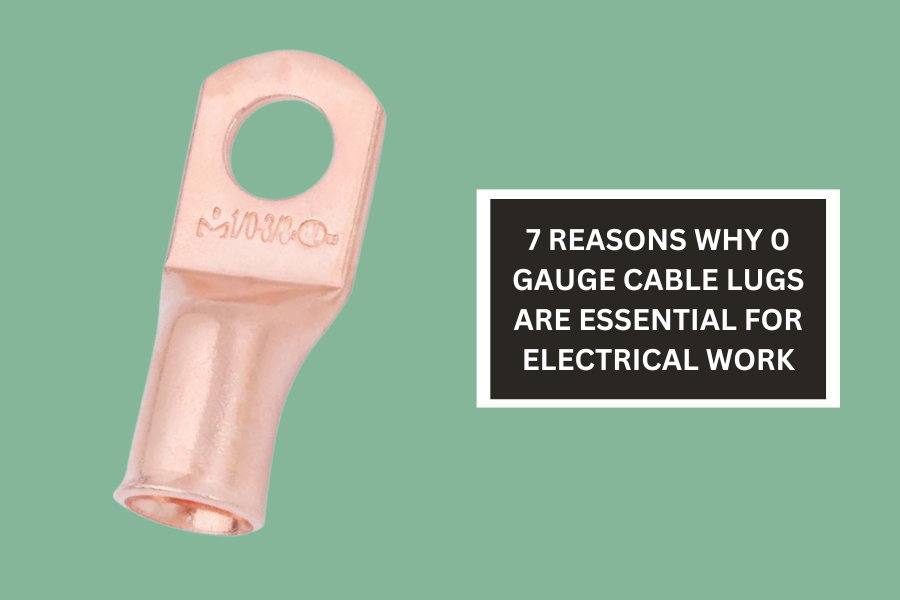Electrical work demands precision and safety. As well as the use of components that can handle the demands of modern electrical systems. When dealing with high-current applications, 0 gauge cable lugs become indispensable for creating robust, reliable, and code-compliant connections. Let’s delve into the top reasons why 0 gauge cable lugs are a must-have in the electrician’s toolbox.
0 gauge (often expressed as 1/0 and pronounced “one aught”) is a thick conductor in the American Wire Gauge (AWG) system. It possesses a large cross-sectional area, making it capable of carrying significant electrical currents. Without excessive heating or voltage drop.
What is a 0 Gauge Cable Lug?
A 0 gauge cable lug is an electrical connector specifically designed to terminate 0 gauge wires. These lugs provide a secure and convenient way to connect these large wires to various electrical components. They are available in a variety of configurations to suit different applications. Some common uses for 0 gauge cable lugs include:
- Power Distribution: In electrical panels, subpanels, and busbar systems, 0 gauge lugs are used to connect feeder cables to busbars. Which then distribute power to individual circuits.
- Heavy Machinery: Industrial equipment and machinery often require significant electrical currents. 0 gauge lugs are used to connect these machines to power sources and provide connections between internal components.
- Battery Banks: In solar power systems, off-grid setups, and recreational vehicles with multiple batteries. 0 gauge lugs are employed to securely connect the batteries together in parallel or series configurations.
- Automotive Sound Systems: For car audio enthusiasts running high-powered amplifiers and subwoofers. 0 gauge lugs are essential for ensuring a reliable connection. Between the battery, distribution block, and amplifier.
By using a cable lug instead of simply terminating the bare wire. Electricians can create a professional and secure connection that offers several advantages over a bare-wire connection. Lugs provide a larger surface area for contact. Improving conductivity and minimizing potential overheating. They also protect the wire strands from fraying or damage during termination and installation. Additionally, lugs make connecting wires to terminals, busbars, or other components much easier and more efficient.
7 Reasons 0 Gauge Lugs are Essential
- High-Current Capacity: The primary reason for using 0 gauge wire and its corresponding lugs is their ability to handle high electrical currents. This makes them perfect for applications such as:
- Automotive audio systems with powerful amplifiers
- Heavy-duty machinery and industrial equipment
- Power distribution within a building or facility
- Connecting battery banks for solar systems or recreational vehicles
2. Reduced Voltage Drop: Voltage drop is the loss of electrical potential along a conductor due to its resistance. Using 0 gauge wires and lugs minimizes voltage drop, ensuring your equipment receives the power it needs to operate correctly.
3. Minimized Overheating: When undersized wires are used to carry large currents, they can overheat. This poses a fire hazard and can damage equipment. 0 gauge lugs, paired with the right wire, help prevent overheating for safer installations.
4. Code Compliance: Many electrical codes mandate the use of specific wire sizes and corresponding lugs based on the current draw and application. Using 0 gauge lugs ensures that your electrical systems meet code regulations and safety standards.
5. Durability and Reliability: 0 gauge lugs are usually made from heavy-duty materials like copper. Which has exceptional conductivity and corrosion resistance. Their robust construction ensures a long lifespan, particularly in demanding environments.
6. Ease of Installation (with the right tools): While working with thick 0 gauge wire requires some specialized tools. The actual connections made with 0 gauge lugs are often straightforward. Lugs may have bolt connections for easy tightening, or they might be designed for crimping. Which provides a secure and reliable bond after using the appropriate crimping tool.
7. Versatility: 0 gauge lugs are available in various configurations, such as:
- Straight lugs: For simple, in-line connections
- Angled Lugs: Helpful when space is limited, allowing for bends in the wire
- Lugs with Multiple Holes: Accommodate several wires or create connection points for multiple devices.
Choosing the Right 0 Gauge Lug
To ensure the success of your project, select 0 gauge lugs with the following factors in mind:
- Material: Copper is the gold standard, offering excellent conductivity and corrosion resistance. Aluminum offers a more cost-effective option but necessitates precautions to prevent galvanic corrosion when used with copper conductors.
- Plating: Tin-plated lugs provide enhanced corrosion resistance in harsh environments.
- Hole Size and Type: Ensure the lug’s hole matches your mounting hardware (bolts or screws). Consider single-hole, two-hole, or slotted lugs depending on your requirements.
- Certifications: Look for lugs listed by recognized agencies like UL (Underwriters Laboratories) or CSA (Canadian Standards Association) to assure quality and safety.
In Conclusion
0 Gauge Copper Lugs are not just an accessory—they are vital for any electrical project that requires handling substantial currents. By understanding their advantages, the different designs available. And the key factors for choosing them, you can make informed decisions to enhance the safety, efficiency, and reliability of your electrical systems. Invest in proper 0 Gauge Copper Lugs for robust and compliant connections that stand the test of time.










